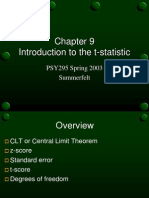Stat LAS 2024
Stat LAS 2024
Uploaded by
umorherlatipCopyright:
Available Formats
Stat LAS 2024
Stat LAS 2024
Uploaded by
umorherlatipOriginal Description:
Original Title
Copyright
Available Formats
Share this document
Did you find this document useful?
Is this content inappropriate?
Copyright:
Available Formats
Stat LAS 2024
Stat LAS 2024
Uploaded by
umorherlatipCopyright:
Available Formats
Name: Grade & Section: Grade XI - ______
Subject: Statistics and Probability Teacher: ___ Score:
Lesson: Quarter 3 Week 8
Activity Title: Percentiles and T-Distribution
Learning Target(s): 1. Illustrate the t-distribution (M11-12SP-IIIg2)
2. Identify the percentile using the t-table (M11-12SP-IIIg5)
Reference(s):
Background Information for Learners
The t-distribution (also called Student’s t-distribution) is a family of distributions that look almost
identical to the normal distribution curve, only a bit shorter and stouter. The t-distribution is used instead of the
normal distribution when you have small samples. The larger the sample size, the more the t distribution looks
like the normal distribution. In fact, for sample sizes larger than 20 (e.g. more degrees of freedom), the
distribution is almost exactly like the normal distribution.
The t-distribution is similar to a normal distribution. It has a precise mathematical definition. Instead of
diving into complex math, let’s look at the useful properties of the t-distribution and why it is important in
analysis of any set of statistical quantitative data.
Like the normal distribution, the t-distribution has a smooth shape.
Like the normal distribution, the t-distribution is symmetric. If you think about folding it in half at the
mean, each side will be the same.
Like a standard normal distribution (or z-distribution), the t-distribution has a mean of zero.
The normal distribution assumes that the population standard deviation is known. The t-distribution
does not make this assumption.
The t-distribution is defined by the degrees of freedom. These are related to the sample size.
The t-distribution is most useful for small sample sizes, when the population standard deviation is not
known, or both.
As the sample size increases, the t-distribution becomes more similar to a normal distribution.
Let us be familiar first with the following words:
1. Degree of freedom - This refers to the maximum number of logically independent values which vary
in the data sample.
2. Percentile – This is a measure of position with data divided into 100 parts. Below is the t-table which
you can use to find the t-value
Illustrative Example:
1. Identify the t-value whose number of samples n = 7 and has an area (𝛼) equal to 0.05.
Solution:
To identify the t-value, identify first the degree of freedom using the formula df= n-1 where n is the
sample size. df = n-1
df = 7-1
df = 6
Locate the t-value on the t-table using the degree of freedom and the area (𝛼)
Therefore, the t-value with sample size of 7 and has 𝛼 = 0.05 is 1.943.
2. Find the t-value whose degree of freedom is 20 and has 𝛼 = 0.01.
Solution: Since the degree of freedom and 𝛼 are already given locate the t-value on the t-table.
Therefore the t-value is 2.528.
3. Identify the t-value of the following percentiles given the number of samples.
a. 95th percentile , N= 30
The 95th percentile is the number where 95% of the values lie below it and 5% lie above it, so you
want the right-tail area to be 0.05. Move across the row, find the column for 0.05, and then locate the
t-value using n=30 or df = 29.
So therefore, the t-value of P95 with n= 30 is 1.699.
b. 90th percentile, N=20
The 90th percentile is the number where 90% of the values lie below it and 10% lie above it,
so you want the right-tail area to be 0.01. Move across the row, find the column for 0.05, and
then locate the t-value using n=20 or df = 19.
Therefore, the t-value of 90th percentile with n= 20 is 1.328.
Activity 1: Complete Me
Complete the table below by identifying the degree of freedom, right-tailed area and the t-value for each
percentiles and the sample size.
Activity 2: Examine Me
Rowena wants to test a randomly selected 20 students for her study. Identify the t-value of the following
percentiles.
1. 75th percentile
2. 5th percentile
3. 60th percentile
4. 40th percentile
5. 90th percentile
Activity 3: Topnotcher!
A researcher conducts a diagnostic examination to 20 students. The following are the interpretation of
the diagnostic examination.
1. James got a score which is 60% higher than those who took the diagnostic test.
2. Rowena has a percentile rank of 90.
3. Jimuel got a score which is only 5% higher than those who took the diagnostic test.
4. Joanna has a percentile rank of 75.
5. Lester is 90% lower than those who took the diagnostic test.
Identify the t-value of the percentiles of the following by filling up the table:
Questions: 1. Who do you think got the highest score?
2. Who do you think passed the diagnostic examination?
You might also like
- WEEK 8 Percentiles and T DistributionDocument6 pagesWEEK 8 Percentiles and T DistributionCresilda Mugot100% (1)
- T DistributionDocument4 pagesT DistributionEr Rajesh BuraNo ratings yet
- 4915536Document123 pages4915536josephvanbac89% (18)
- Tyre Technology ConferenceDocument20 pagesTyre Technology ConferenceChaiwat PhollookinNo ratings yet
- SLHT Week 7Document5 pagesSLHT Week 7shaleme kateNo ratings yet
- Percentile and The T-Distribution: Melc Competency CodeDocument8 pagesPercentile and The T-Distribution: Melc Competency CodeErnie LahaylahayNo ratings yet
- Percentile and T DistributionDocument15 pagesPercentile and T DistributionLeigh OnceNo ratings yet
- Problem Solving With Linear Models Education Presentation in Blue Black Ye - 20240321 - 214317 - 0000Document23 pagesProblem Solving With Linear Models Education Presentation in Blue Black Ye - 20240321 - 214317 - 0000marcosmariamo51No ratings yet
- Percentileand TDistributionDocument35 pagesPercentileand TDistributionRhea Rose AlmoguezNo ratings yet
- STATS T DistributionDocument18 pagesSTATS T DistributionNecil PaderanNo ratings yet
- Lesson 23: Tests of Hypotheses - Small SamplesDocument5 pagesLesson 23: Tests of Hypotheses - Small SamplesWinny Shiru MachiraNo ratings yet
- T DistributionDocument7 pagesT Distributionr9653931No ratings yet
- Costructs T Distribution (Dianne)Document9 pagesCostructs T Distribution (Dianne)Dianne RuizNo ratings yet
- How To Find Percentiles For A T-Distribution: Statistics For Dummies, 2nd EditionDocument5 pagesHow To Find Percentiles For A T-Distribution: Statistics For Dummies, 2nd EditionNielyn WPNo ratings yet
- 102 02 AnswersDocument17 pages102 02 AnswersmanojNo ratings yet
- Madlain Ojt W2Document39 pagesMadlain Ojt W2rich.lamostreNo ratings yet
- Central Limit Theorem T Distribution PercentileDocument11 pagesCentral Limit Theorem T Distribution PercentileMarco ZoletaNo ratings yet
- Week 7: The T Distribution, Confidence Intervals and TestsDocument51 pagesWeek 7: The T Distribution, Confidence Intervals and TestsHussein RazaqNo ratings yet
- T DistributionDocument26 pagesT DistributionJDR JDR0% (1)
- Stats 2 Module UpdatedDocument33 pagesStats 2 Module Updatednandgaonkarmahesh041No ratings yet
- Estimation of Parameters Part IDocument46 pagesEstimation of Parameters Part IAlthea MadarangNo ratings yet
- Statistics & Probability Q4 - Week 3-4Document16 pagesStatistics & Probability Q4 - Week 3-4Rayezeus Jaiden Del RosarioNo ratings yet
- LAS 9 Statistics and Probability - 042027Document9 pagesLAS 9 Statistics and Probability - 042027Shane R. FelominoNo ratings yet
- T DistibutionDocument25 pagesT DistibutionFritz AstilloNo ratings yet
- F, T TestDocument21 pagesF, T TestKamini Satish SinghNo ratings yet
- 4th Quarterly 1st Topic 1Document27 pages4th Quarterly 1st Topic 1Negad, G.E.R - ingenuityNo ratings yet
- T TESTDocument5 pagesT TESTMeenalochini kannanNo ratings yet
- Statistics and Probability PDFDocument12 pagesStatistics and Probability PDFCvNo ratings yet
- Probability TheoryDocument354 pagesProbability TheoryMohd SaudNo ratings yet
- Chap1 Lesson 2Document10 pagesChap1 Lesson 2Jun PontiverosNo ratings yet
- Discussion of PercentileDocument32 pagesDiscussion of Percentilegreatchelle sumayangNo ratings yet
- GROUP - 9 - T-Distribution and PercentileDocument45 pagesGROUP - 9 - T-Distribution and PercentileEditorialranged CartoonistoplaneNo ratings yet
- Lesson+4.3++ +the+t DistributionDocument51 pagesLesson+4.3++ +the+t DistributionZander Ezekiell FernandezNo ratings yet
- Z Test FormulaDocument6 pagesZ Test FormulaE-m FunaNo ratings yet
- The T DistributionDocument25 pagesThe T DistributionJamhur StNo ratings yet
- Lesson 3 - T-Distribution (Module)Document26 pagesLesson 3 - T-Distribution (Module)charmaine marasigan100% (1)
- Summary StatisticsDocument28 pagesSummary StatisticsJorie RocoNo ratings yet
- 05 Statistical Inference-2 PDFDocument14 pages05 Statistical Inference-2 PDFRama DulceNo ratings yet
- Part 6 - Week 07 Students TDocument13 pagesPart 6 - Week 07 Students TJane DoeNo ratings yet
- Final Q4 Week89 Minilesson Math 10 LASWHLPDocument8 pagesFinal Q4 Week89 Minilesson Math 10 LASWHLPibasanpenzaNo ratings yet
- Day 13 - Intro To T StatisticDocument7 pagesDay 13 - Intro To T StatisticLianne SedurifaNo ratings yet
- Measures of Central TendencyDocument13 pagesMeasures of Central TendencyDrAmit VermaNo ratings yet
- Notes 515 Fall 10 Chap 6Document12 pagesNotes 515 Fall 10 Chap 6Sultana RajaNo ratings yet
- T - TestDocument45 pagesT - TestShiela May BoaNo ratings yet
- Psych Stats ReviewerDocument16 pagesPsych Stats ReviewerReycee AcepcionNo ratings yet
- Standard and Quartile DeviationDocument7 pagesStandard and Quartile DeviationGemine Ailna Panganiban NuevoNo ratings yet
- S2 - Q4l9statppt10Document110 pagesS2 - Q4l9statppt10Shereen Grace GaniboNo ratings yet
- Lec 1Document54 pagesLec 1Jayveer SinghNo ratings yet
- Module 7 T DistirubtionDocument9 pagesModule 7 T Distirubtionromelabejero125No ratings yet
- EX-Hypothesis Test of The MEANDocument5 pagesEX-Hypothesis Test of The MEANBobbyNicholsNo ratings yet
- Math11 SP Q3 M8 PDFDocument12 pagesMath11 SP Q3 M8 PDFJessa Banawan EdulanNo ratings yet
- Introduction To The T-Statistic: PSY295 Spring 2003 SummerfeltDocument19 pagesIntroduction To The T-Statistic: PSY295 Spring 2003 SummerfeltEddy MwachenjeNo ratings yet
- EstimatationDocument21 pagesEstimatationOduntan DanielNo ratings yet
- STATISTICS Q3 WEEK-9 Revision-3Document17 pagesSTATISTICS Q3 WEEK-9 Revision-3ace fuentesNo ratings yet
- Module 7 ModifiedDocument16 pagesModule 7 ModifieddoricxdNo ratings yet
- GCSE Maths Revision: Cheeky Revision ShortcutsFrom EverandGCSE Maths Revision: Cheeky Revision ShortcutsRating: 3.5 out of 5 stars3.5/5 (2)
- Statement of WorkDocument7 pagesStatement of WorkSabria Omar100% (1)
- MCQ - Class 9 - Atoms and MoleculesDocument28 pagesMCQ - Class 9 - Atoms and Moleculesget2maniNo ratings yet
- Pag 6-10 InglesDocument5 pagesPag 6-10 InglesjosepaddaiperezenriquezNo ratings yet
- Session 14-Porter 5 Forces ModelDocument21 pagesSession 14-Porter 5 Forces ModelRachmatya PratamiNo ratings yet
- Zakat DeclarationDocument1 pageZakat DeclarationSyed Mohsin SheraziNo ratings yet
- Restricting and Sorting Data QuestionsDocument22 pagesRestricting and Sorting Data QuestionsAnkit BhargavaNo ratings yet
- Slip-On Flanges Class 150: ANSI B 16.5 / B16.47 ADocument1 pageSlip-On Flanges Class 150: ANSI B 16.5 / B16.47 ABastian VillarroelNo ratings yet
- Must-Have Measurements For Comfortable Seating PDFDocument2 pagesMust-Have Measurements For Comfortable Seating PDFVipin WilfredNo ratings yet
- Determinants of Capital Structure in Developing Countries: December 2010Document39 pagesDeterminants of Capital Structure in Developing Countries: December 2010yockydockyNo ratings yet
- Justin Anson Distillery, Inc.Document6 pagesJustin Anson Distillery, Inc.Irtaza Zaidi0% (1)
- LPC84 XDocument100 pagesLPC84 XMauricio ScalerandiNo ratings yet
- COMPENTENCY EVALUATION OF CONTRACT EMPLOYEE AT TATA STEEL GROWTH SHOP by HR - Jyoti KumarDocument63 pagesCOMPENTENCY EVALUATION OF CONTRACT EMPLOYEE AT TATA STEEL GROWTH SHOP by HR - Jyoti KumarJYOTI KUMARNo ratings yet
- Mba205 HRMDocument158 pagesMba205 HRMyogeshgharpure100% (1)
- Talent Acquisition and Talent ManagementDocument77 pagesTalent Acquisition and Talent Managementsm_ipu100% (4)
- Dokumen - Pub Generalized Trigonometric and Hyperbolic Functions 1138333018 9781138333017Document212 pagesDokumen - Pub Generalized Trigonometric and Hyperbolic Functions 1138333018 9781138333017Juan CorvalanNo ratings yet
- Design As Bricolage: Anthropology Meets Design ThinkingDocument25 pagesDesign As Bricolage: Anthropology Meets Design Thinkingbrainfreeze3175No ratings yet
- MotionDocument15 pagesMotionSherilyn ApostolNo ratings yet
- Tales From The Evil Empire - Recovering The Admin Password in OrchardDocument3 pagesTales From The Evil Empire - Recovering The Admin Password in OrchardActive6No ratings yet
- Five Day Trip To Sweden HNDocument5 pagesFive Day Trip To Sweden HNJaco_3reeNo ratings yet
- 0 SamDocument9 pages0 Samsamuvel samNo ratings yet
- Heat Capacity of A Debye SolidDocument5 pagesHeat Capacity of A Debye SolidJuly T Widya RNo ratings yet
- Iot Based SriprasannaaDocument23 pagesIot Based Sriprasannaasriprasannaa pNo ratings yet
- Name: Syelesh.A Objective: English, Tamil, Russian, TeluguDocument2 pagesName: Syelesh.A Objective: English, Tamil, Russian, TeluguRajesh BarathamaniNo ratings yet
- Abap Accenture Test1Document5 pagesAbap Accenture Test1Ichigo MangekNo ratings yet
- Cisco SD WanDocument2 pagesCisco SD WanKurabiye CanavarıNo ratings yet
- Chapter 4Document14 pagesChapter 4Khay OngNo ratings yet
- Test Bank For Microbiology With Diseases Body System 3rd Edition BaumanDocument21 pagesTest Bank For Microbiology With Diseases Body System 3rd Edition BaumanStan Mcclellan100% (38)
- Exploring The Curriculum: Field StudyDocument8 pagesExploring The Curriculum: Field StudyRoxane RiveraNo ratings yet

























































































